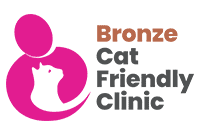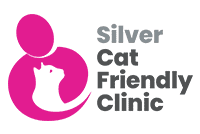What is hyperthyroidism?
Hyperthyroidism (overactive thyroid disease) is a common disease affecting older cats whereby one (or both) of the thyroid glands in the neck become enlarged and produce excessive thyroid hormone. This is usually a benign enlargement but can rarely (1-2%) be a malignant tumour. The excessive thyroid hormone sets the cat's metabolism into overdrive, burning up energy.
What signs may suggest hyperthyroidism?
Common signs may include weight loss despite a good or increased appetite, increased thirst, poor fur condition, hyperactive behaviours, sickness or diarrhoea. The vet may detect a fast heart rate, abnormal heart rhythm or murmurs and an enlarged thyroid gland.
How do we diagnose the problem?
Generally, hyperthyroidism is easily detected with a blood test (total thyroid level) which we can perform at our in-house laboratory at Shires Vets. It is important that we also check your cat's kidneys and other organ functions to ensure no other concurrent problems are present.
If signs are suspicious of hyperthyroidism but the total thyroid level is normal then we may request further thyroid parameters to be tested by an external laboratory.
Why treat hyperthyroidism?
Untreated, hyperthyroidism greatly shortens lifespan and leads to heart failure, high blood pressure (which can cause sudden blindness & kidney damage), further weight loss and loss of quality of life. However, compared to some other older cat problems, we have several successful options to help manage the condition in the long run and give them a good outlook.
How can I treat my cat's hyperthyroidism?
There are several options for you to consider, each with potential pros and cons and each may suit different individual cats, households and budgets. Daily tablets or gel smeared on ears can be used lifelong to manage the condition and is most common. A prescription thyroid diet can control the signs. Radioactive iodine administration is a treatment option which has a high success rate of curing the problem and is probably the 'gold standard choice'. Surgery to remove the affected glands can cure the problem equally. Further information on each of these options follows. It should be noted that on treating your cat's hyperthyroidism a hidden kidney disease could be uncovered with the reduced metabolic rate. We therefore suggest monitoring kidney function (especially over the initial 12 months after treatment) periodically. Hypertension (high blood pressure) can occasionally develop, even during the first year of managing hyperthyroidism, so ideally this is also monitored, as appearance necessitates treatment to prevent other organ damage (see above 'Why treat hyperthyroidism').
Oral anti-thyroid medications
e.g. Vidalta, Felimazole
- Most common form of management. No anaesthetics or surgery is required. Treatment at home with visits to vets for checkups.
- Requires ongoing daily dosing as stopping them causes relapse of signs.
- Recheck appointments with the vet to check thyroid blood levels 3-4 weeks after starting tablets or adjusting the dose then every 3 months.
- Some cats are not amenable to having tablets, however, it is worth trying with a pill giver or hiding in food. Vidalta is given once daily, and Felimazole twice daily
- Possible side effects include sickness, diarrhoea, poor appetite, lethargy, skin irritation, anaemia and white blood cell disturbances, which are uncommon but generally resolve with stopping medication. Alternative options would then need consideration.
- Estimated costs: £25-35 per month for either brand of tablet. When first introduced or after a dose adjustment we would reassess and recheck thyroid levels after ~3 weeks. 3 monthly checks once stable would be necessary to ensure your cat is on the right dose of medication as this can change over time. Each repeat consult is £22.25; Thyroid test is £28.44; kidney blood tests (~£10) and blood pressure checks (£25) would be additional if chosen.
Topical methimazole gel
- This is a topical gel that you would smear on the inside skin of your cat's ear twice daily with gloves which contains a similar drug to the above tablets.
- This medication is unlicensed (i.e. full testing has not been undertaken to prove efficacy and safety) however in cats who are impossible to tablet this option has proven effective in some cases.
- Side effect risks as above plus the risk of absorption through skin being ineffective.
- Estimated costs: £30-60 per month for the gel depending on the dose required. Reassessments same as for tablets.
Radioactive iodine treatment:
- This is a safe and effective option which is 90-95% effective at curing hyperthyroidism completely. Effects are often seen within a month, though may take up to 6 months.
- This is only performed at a few specialist centres in the UK, but involves injection of radioactive iodine under the skin which has its effects only in the overactive thyroid tissue. Your cat would then need hospitalisation at the centre for 5-7 days whilst the radioactivity reaches safe levels for you to handle at home afterwards for the following month.
- Estimated costs: full evaluation of kidneys, urine testing & blood pressure etc before referral to the specialist approx. £150. Radioactive iodine treatment £1800 (at Hyperthyroid Cat Centre, Wetherby)
Prescription diet control
- Success has been seen in cats fed solely this iodine-restricted diet (Hills Y/D). It avoids surgery or tabletting and is available in wet/tinned and dry/biscuit forms. It is an option suited to indoor-only single-cat households.
- If the cat eats any other food or hunts then the benefit is negated and hyperthyroidism persists. If the cat develops another disease later in life or goes off the prescription diet then, again, the hyperthyroidism returns.
- Estimated costs: Dry form approx. 80p -120p per day. Wet form is more expensive, but could feed a mix of both if preferred.
Surgical removal of thyroid gland (Thyroidectomy)
- Thyroidectomy involves removing the enlarged thyroid gland, on the underside of the neck near the windpipe, to stop the excess thyroid hormone production. This effectively stops excess production from the affected gland.
- However, it should be noted that cats have two thyroid glands and frequently the other gland becomes enlarged. Typically 75% of cats will need the other thyroid gland removed in 6-24 months.
- To reduce anaesthetic risks it is preferable to reduce the cat's thyroid levels to more normal levels before surgery, so tablets, topical gel or diet could be used to achieve this initially (2-3 months)
- It is not advisable to have both glands removed at the same time, even if the 2nd gland is small at the time as surgery can disturb the parathyroid glands and lead to more serious complications involving low calcium. The parathyroid glands are involved in regulating calcium levels and are closely attached to the thyroid gland and surgery aims to identify and preserve this tissue, however, one potential complication of surgery (quite commonly seen if two sides are removed but possible if only one side removed) is low calcium which causes twitching, weakness and possible fitting and death if undetected. This can be managed with supplementation whilst the tissue recovers if occurs.
- Additionally, hidden thyroid tissue can rarely exist and would not be removed by such surgery. In some cats, the enlarged thyroid is not palpable on the neck which means surgery cannot be pursued as an option.
- Estimated cost of surgery: ~£350 (includes anaesthesia, fluid therapy, surgical removal of the single gland, pain relief, post-op checks etc)










